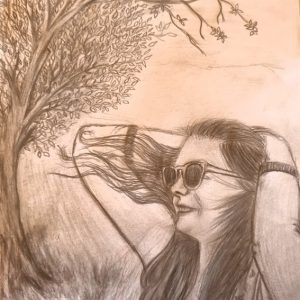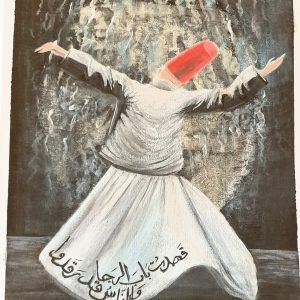Paintings of Radwa Alnazer at the Canvases of the Future exhibition
‘I try to paint the inspirations that affect me.’
A Conversation with Radwa Alnazer
Translation is available for this content
Váltás magyarraRadwa Alnazer was born in Damascus and moved to Hungary before the Syrian civil war. She has been drawing since she was a child. She first studied psychology at university, and later art therapy. Today, she works as a teacher, activist, painter, quilling artist and art therapist. She has thousands of followers on Facebook and Instagram.
Do you keep in touch with your family members?
I miss my country, but in fact most of my family is now scattered around the world – with very few relatives left in Syria. Some of my uncles and aunts live there, and some relatives of my husband. I keep in touch with them. My father is a doctor who graduated as a doctor of internal medicine in Hungary in the 1980s. He is currently studying to be a general practitioner. After university he married my mother. Until I was 4, we all lived here in Hungary. Then I commuted with my mother between Syria and Hungary. Because of the war, we all settled here in 2013. I was still studying in Syria, and my husband graduated from BME here as an architect. We got married in 2015.
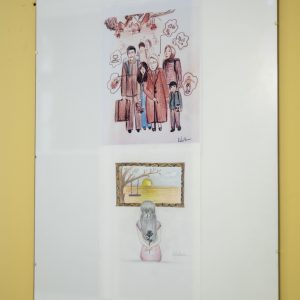
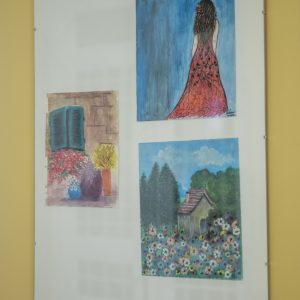
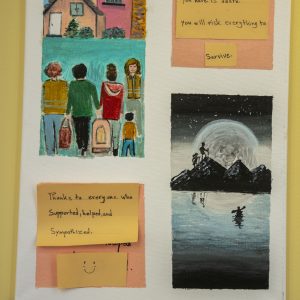
How is your life in Hungary different from your life in Syria?
I don’t feel much difference between the two. I might mention that in Arab countries, social relations are usually closer. Families and groups of friends there meet more often.
To what extent have the attitudes of people and authorities changed here since the 2015 refugee crisis?
I feel like people are afraid of foreigners living here because they don’t have a personal relationship with them. I don’t have any problem with the authorities.
Your little son is 3 years old. What is parenting like as a Syrian in Budapest?
Riad goes to kindergarten and constantly asks about the Hungarian names for things. He is slowly learning Hungarian. The kindergarten environment is very accepting. In general, thank heavens, I don’t feel any discrimination – except maybe they look at us strangely on the street sometimes. I think the reason for that is that we look different than the people here.
You have been teaching at the Al Wahda Arabic School since 2015. What subjects?
The Al Wahda operates at the Libyan Embassy in Budapest. There are 6-7 students in a co-educational class. Education lasts from the first grade to the eleventh grade. I teach psychology, philosophy and art to high school students and students preparing for high school. Art therapy effectively aids students ’self-expression and overall development. I also give traditional drawing lessons.
You draw a lot, paint and make pictures using the quilling technique. What inspires you to create?
Painting and drawing have been my hobbies since I was a child. This was followed by psychology. I thought then that – by combining my hobby and my studies – I could use both painting and psychology in art therapy. The truth is, while painting, one paints one’s feelings. And then, when the ‘great work’ is done, it feels really good to be able to get everything out of one’s system. At the same time, I try to convey some message in my work. I try to paint the effects and inspirations that affect me. For example, I recently read about Hypatia of Alexandria – the first known female polyhistor who was killed for her thoughts – and I painted her. They are often inspirational people. Another time I drew a girlfriend whose mother is Syrian and whose father is Hungarian, and who lived in Syria but fled here during the war. Then my girlfriend managed to get out to England. Since then she’s graduated, and I think that’s a beautiful story. That’s why I made this picture of her.
And how long have you been quilling?
One year. I first tried to form Arabic letters from the paper, and then I tried Hungarian writing. I make these mostly as gifts for acquaintances. I think it’s much more personal than just buying them something. I often write their names with this technique, or create symbols that are dear to them such as flowers or birds. I have already made some for several nursery nannies, and I gave the principal one where I wrote the name of the nursery in this way (Fehérholló).
Is there another painting you could tell a story about?
For example, here is the Sufi Dervish. Sufi is a very peace-loving branch of the Islamic religion. The Sufi branch accepts people; and the essence of its philosophy is forgiveness. Maybe that’s what I like about it. I want mutual acceptance and love to spread throughout the world. Many people follow this religion, and there are a lot of whirling dervishes in Syria as well. The poet Jalal ad-Din Rumi was the founder.
In the long run, do you envision yourself as an art therapist, activist, teacher or artist?
I really like teaching and one of my goals is to teach art therapy at a larger organisation. Of course I also want to volunteer. I always imagine myself painting even in my old age. I look forward to the summer break. I will have more time after school closes. I would also like to learn English and Hungarian properly. These are my immediate goals.
Zoé Tímár

